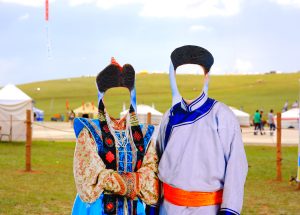Every summer, from July 11 to 15, Mongolians wear their traditional clothes, deel, unite with their families and friends, and celebrate the summer festival, Naadam. In the last decade, Mongolia’s Naadam celebration has modernized, grown, and became more international.
Traditionally, the Naadam Festival symbolizes Mongolia’s independence, sovereignty, national unity, statehood, history, culture, heritage, and customs. Therefore, Naadam is highly regulated even as it is celebrated throughout the country. Each of the 21 provinces of Mongolia organizes distinct Naadam festivals.
The opening ceremony of the Naadam Festival convenes in the National Sports Stadium near the capital, Ulaanbaatar. Chinggis Khaan’s Great White Banners once again rise to unify Mongolians around the world every summer, and Mongolia celebrates its history, including its modern-day revolution, and the ebbs and flows of the Mongol Empire.
This year’s Naadam theme was “Eternal Unity” and its featured historical tales and founding myths. According to Monstame, the opening ceremony including “six chapters” titled “The Everlasting Unity Hymn, The Great Epic, The Time of Great Mongol Destiny, The Migration of the Three Times, The Altan Tevsh Valley, and World Mongol.”
More than 1,500 artists, singers, dancers, horse artists, and craftsmen participated in the opening ceremony, including perhaps the largest variety of local talents yet.
According to Mongolia’s Minister of Culture Nomin Chinbat, “The successful opening ceremony demonstrated the foundation, future vision, valuable nomadic heritage, history, culture, unity, and the harmonious connection between humans and nature. In preparation alone, over 4,000 professional and freelance artists, industry workers, and employees from 79 cultural and artistic organizations have collaborated.”
In a separate venue, a collaboration between Rio Tinto, the Mongolian National University of Arts and Culture, and the Arts Council of Mongolia showcased Mongolia’s heritage, particularly folk art and nomadic craft forms.
The newly appointed U.S. ambassador to Mongolia, Richard Buangan had high praise for the festival: “These few days have been absolutely incredible. I think Mongolia should hold Naadam all year long.”
During Naadam, various traditional sports competitions such as national wrestling, archery, national horse racing, and ankle archery are organized, and special titles and decorations are also awarded.
This year’s Naadam also included the “Mongolian Pride” photo exhibition, the Deeltei Mongol festival, the “Beauty of Mongolia” art exhibition, public entertainment, the President’s Honorary Event, and the Cultural Festival, which together encompass a wide range of activities for domestic and foreign tourists.
In many ways, Naadam is a way for Mongolia to celebrate its history and achievements, while showcasing modern Mongolia on an international stage. As Ulaanbaatar aims to diversify its economy, tourism is viewed as a potential revenue stream. Mongolia’s government has designated 2023-2025 as the “Years to Visit Mongolia.” The government’s post-COVID recovery plan includes a “Welcome to Mongolia” initiative as part of its plan for increasing tourism, with the goal of reaching 1 million tourists in 2023.
In the quest to boost tourism, Naadam plays an important role in showcasing the country’s culture and traditions while providing opportunities for local businesses, entrepreneurs, and travel agencies. The successful organization of Naadam, in turn, makes Mongolia a bit more internationally relevant each year. In the last decade, Naadam has become one of Mongolia’s major cultural attractions for tourists, researchers, and Mongolia enthusiasts. These efforts have strengthened the collaboration between the government, the private sector, and the global community.
Another factor in Nadaam’s internationalization is the growth of the Mongolian diaspora. As Mongolians migrate to different continents, the establishment of Mongolian communities around the world helps to preserve Mongolian traditions, cultural activities, and national holidays and festivals such as Naadam and the Mongolian Lunar New Year. Mongolian communities in the United Kingdom, Europe, Australia, Canada, and the United States are all active in celebrating the annual Naadam festival.
As Mongolia strives to transition to an advanced democracy, its culture and heritage must modernize without losing their essence. Naadam, too, has modernized, and its cultural prevalence provides momentum on an international level.
The official framing of Naadam was captured in its 2010 inscription on the Representative List of the Intangible Cultural Heritage of Humanity. According to the entry, “Mongolian Naadam is inseparably connected to the nomadic civilization of the Mongols, who have long practiced pastoralism on Central Asia’s vast steppe. Oral traditions, performing arts, national cuisine, craftsmanship, and cultural forms… also feature prominently during Naadam.”
Mongolians believe that the showcase of nomadic civilization, traditional arts and crafts, dance, and gestures in Naadam is modern Mongolia’s way of passing the torch to a younger, more international generation.
On the other hand, Mongolia is also aiming to make its traditional culture more accessible to non-Mongolians. The Ministry of Culture is providing cultural services to foreigners through affiliated institutions such as museums and libraries. For example, as part of the special cultural programs, the play “Mongolian King” was performed in English, which has been popular among tourists. Theaters and museums are also operating without holidays to cater to the increased tourist demand.
In addition to the Naadam celebration, various provinces are celebrating their 100th anniversary this year, and the Mongolian countryside will be full of festivities organized for both foreign and domestic tourists. The recent sighting of the British actor, Christian Bale, is an inviting sign that Mongolia is becoming a major travel destination.

































